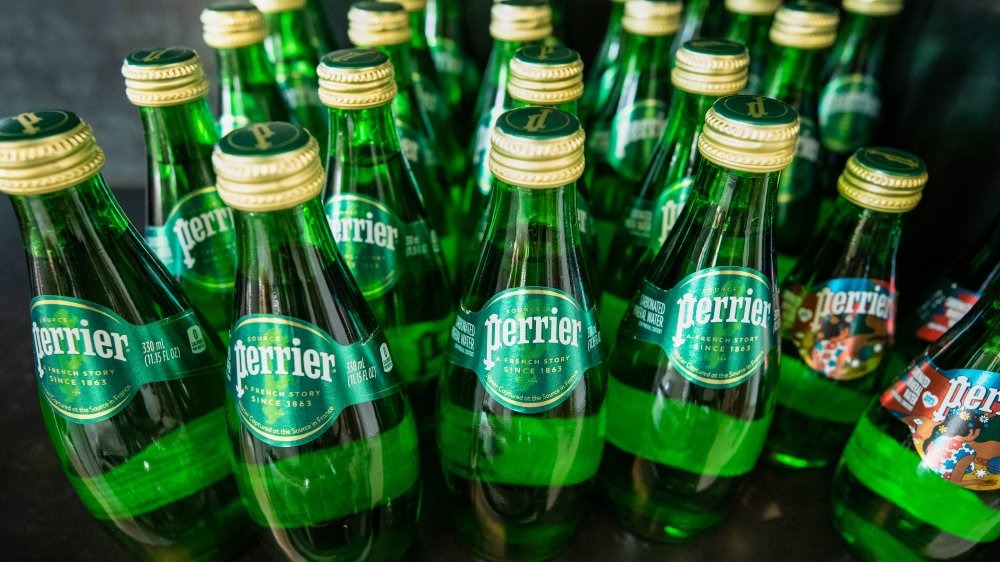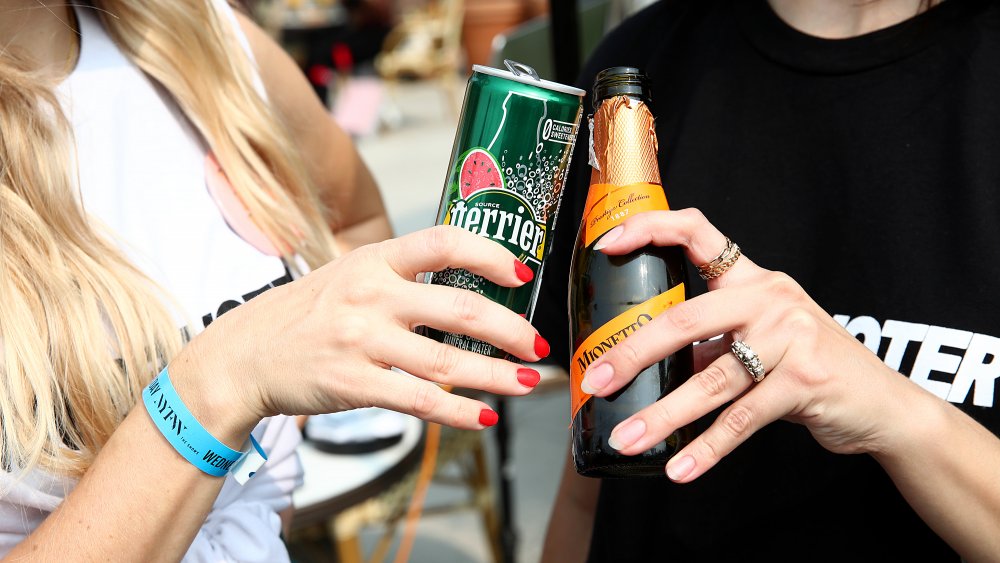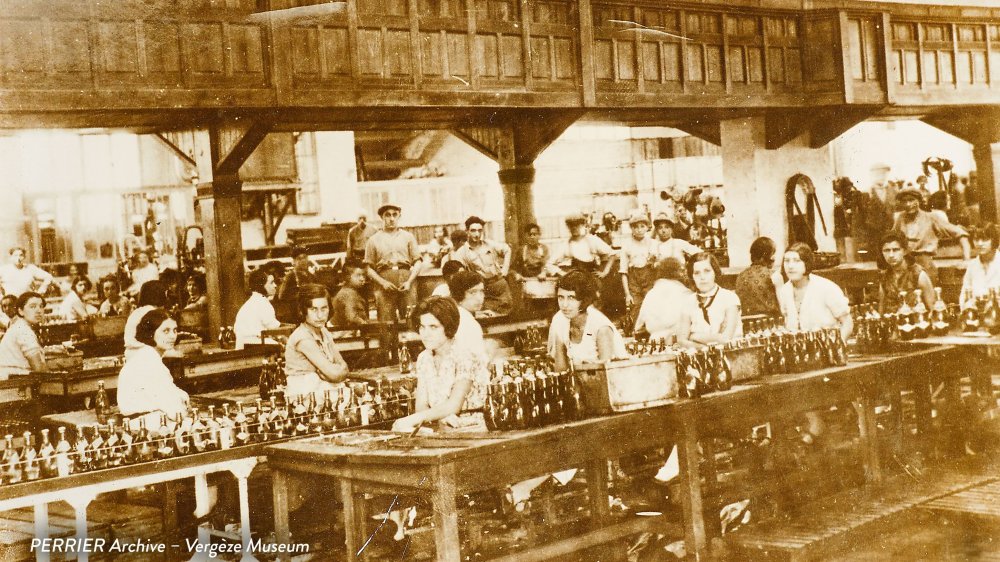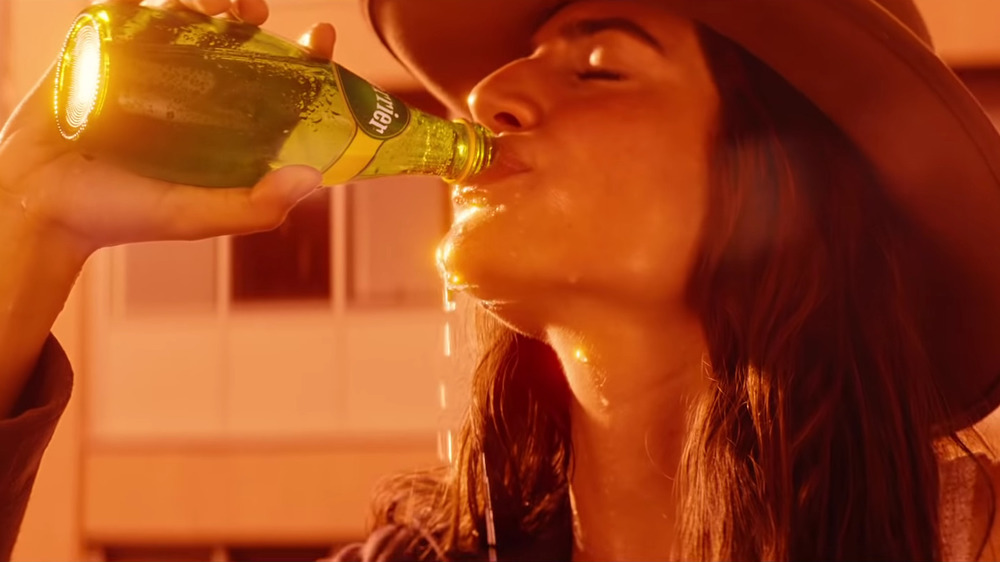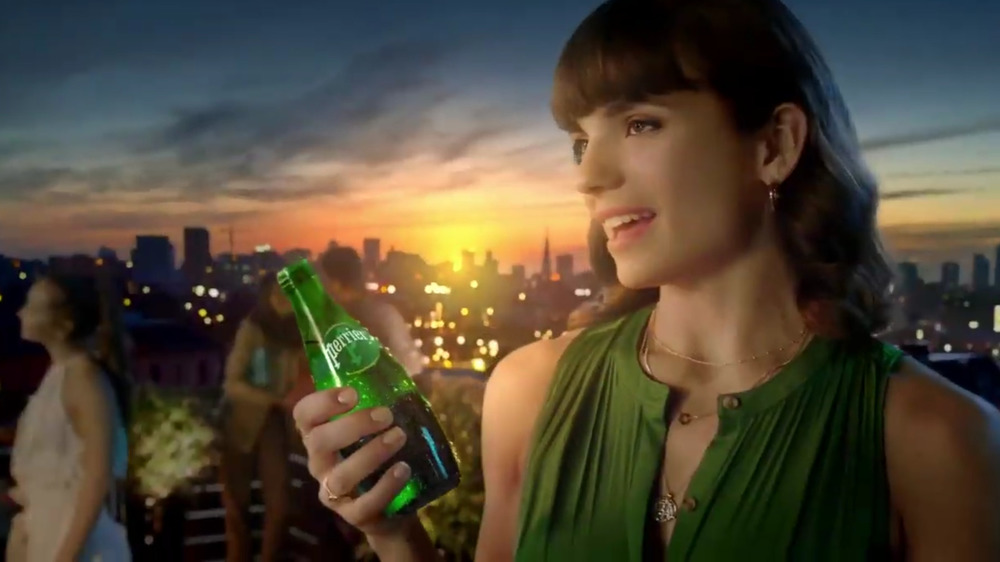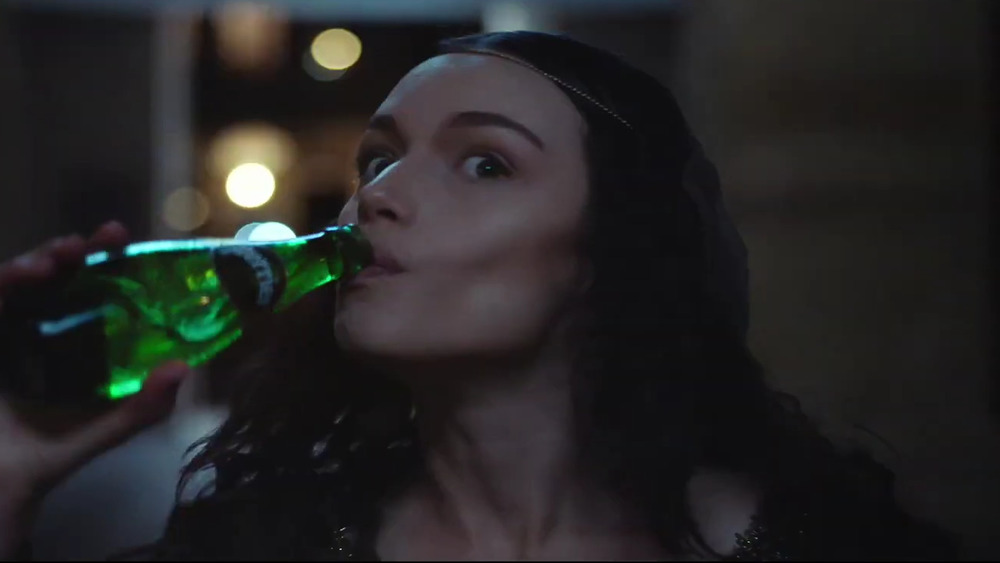The Untold Truth Of Perrier
We may receive a commission on purchases made from links.
To say that sparkling water is trendy might be understating it. Americans drank three times more carbonated water in 2017 than they had just five years earlier (via MarketWatch). Millennials guzzling multiple cans of LaCroix daily may not be aware, but water with bubbles was cool way before their favorite beverage first appeared, in La Crosse, Wisconsin in 1981. Our love of carbonation dates all the way back to Napoleon Bonaparte's nephew. Trace it to its source, and you find the fizzy-water craze comes from a natural spring in the south of France where the water is called Perrier.
Perrier has sold billions of bottles of water (via Let's Look Again) since Napoleon III decreed that the spring in Vergèze, France could be developed into a spa (via Perrier). The spring is still going strong, and despite fierce competition from Instagram-friendly, rainbow-colored cans of LaCroix and Bubly, Perrier holds its own in the marketplace. The onetime French brand, now owned by Nestlé, is the fifth-biggest brand of sparkling water (via Statista). PepsiCo's Bubly, which entered the market in early 2018 (via Beverage Daily), remains behind Perrier in sales.
The famous sparkling water brand has had its share of troubles in its 157-year history. But the brand finds a way to turn crisis into opportunity, right down to its distinctive, pear-shaped bottle. Read on to get the untold story of Perrier's colorful (but mostly green) past and present.
Perrier is naturally carbonated (or is it?)
Perrier might never be the social-media darling its young competitors are, but it's willing to change with the times. Perrier only sold, well, Perrier – pure spring water it claimed was naturally bubbly – until 1985. Perrier then introduced Perrier With a Twist, in lemon, lime, and orange flavors (via The New York Times). This line of flavored Perrier now includes peach, watermelon, strawberry, green apple, and pink grapefruit. In 2019, Perrier infused real juices and sugar into its water to create three offbeat varieties of Perrier & Juice: strawberry and kiwi, peach and cherry, and pineapple and mango (via BevNET). They've since added a fourth Perrier & Juice to that lineup: lemon and guava.
Volcanic activity makes Perrier's spring naturally carbonated – so bubbly, in fact, that Perrier's famous green bottles wouldn't be able to hold the water for long. The water and the bubbles are actually separated, then reintroduced during bottling (via the Independent). The local geology infuses the water with minerals: calcium, chloride, bicarbonate, fluoride, magnesium, nitrate, potassium, sodium, and sulfates (via Slate).
Acid levels in carbonated drinks have caused some people to worry they erode the enamel on our teeth. It turns out that sugary sodas are 100 times worse for our teeth than sparkling mineral water (via Healthline). Run-of-the-mill sparkling waters turn out to be much more acidic than Perrier (via Center for Science in the Public Interest), as are Starbucks coffee, unsweetened tea, and Coca-Cola.
Dr. Perrier decides to market the spring's mineral water
According to Perrier's website, bottles of water from the Les Bouillens spa in Vergèze were available only to its swanky patrons. In 1898, the spa's medical director, one Dr. Louis Perrier, determined the water was therapeutic. He wanted to take the water to market but couldn't afford the cost of mass-bottling it. So the owners sold the spring to a Brit, Sir John Harmsworth, in early 1903. Harmsworth closed the spa and by the end of the year was selling Perrier in markets across southern France (via Let's Look Again).
Legend has it that Harmsworth's Perrier turned tragedy into opportunity in 1906 after he lost the use of his legs in a car crash (via Perrier). As the story goes, Harmsworth used bowling pin-shaped clubs to exercise his upper body. The clubs' shape supposedly inspired Perrier's unique bottle.
During the early decades of the 20th century, Perrier quickly gained popularity in France and Britain. After World War II, Perrier was losing money. The Harmsworth family sold the business in 1946 to a French stockbroker named Gustave Leven, and the French spring water was officially a French company. During Leven's first tour of the facility, he saw workers dipping bottles directly into the spring and then putting the caps on with their feet. Today's health inspectors would not approve.
Perrier's bubble bursts with benzene scare
Perrier's best days came in the late 1970s and the 1980s. That's when the brand started asserting itself in the United States. The company had sold 3 million bottles of water in the U.S. in 1976 but had shot up to 200 million bottles in this mostly untapped market by 1979 (via Let's Look Again). Americans in the 80s were into status symbols and fitness, and Perrier was fortunate to meet both needs. In 1989, Perrier sold 1.2 billion bottles around the world, half of them in the United States. Right after that, the bubble burst.
One day in February 1990, a lab in North Carolina found a tiny amount of cancer-causing benzene in Perrier. Ironically, scientists had been using the bottled water around the lab as a "pure" water source because it contained no organic matter (via Chemical & Engineering News). The benzene level was too low to harm anybody. In fact, people who drink decaffeinated coffee get more benzene than the quantity found in Perrier that day (via ResearchGate). Nonetheless, the discovery proved to be a PR nightmare for Perrier.
The cause of the contamination was traced to a clogged filter that was supposed to remove natural benzene from the carbon dioxide gas. The filter hadn't been checked for six months. Perrier recalled 160 million bottles of water from 120 countries around the world (via PR Week).
Nestle buys Perrier after it loses its sparkle
The benzene scare was bad enough. But in admitting what went wrong, Perrier also exposed the fact that its product wasn't exactly "naturally sparkling," like the label said back in 1990. Thanks to the benzene and the not-so-natural carbonation process, Perrier had to change its label three times in six months (via The Washington Post). Within a couple of years, Perrier had lost half of its sales in the U.S. and the U.K. (via Let's Look Again). Once again in its history, Perrier was a money-loser, and once again it was ripe for a sale. This time around, Nestlé bought Perrier, in 1992, and owns the brand to this day (via Beverage Daily).
Nestlé's purchase was another Perrier crisis becoming an opportunity. Nestlé pounced on the brand while its stock price was low (via PR Week), and a company as enormous as Nestlé doesn't need to worry too much if a relatively small holding such as Perrier isn't making any money. That turned out to be a very good thing for Perrier because in fact it never contributed a penny of profit to Nestlé's bottom line in its first 12 years with its new owner. Perrier's current market share in the U.S. is 8.3 percent (via Statista), still well below its 15 percent share 30 years ago (via PR Week).
Perrier brands itself as the artsy sparkling water
The likely reason Nestlé hasn't flushed the Perrier brand, according to Beverage Daily, is that it has a cachet that might not equate to dollars but does amount to considerable clout. Taylor Swift is reportedly obsessed with Perrier, with no celebrity-endorsement money attached (via Alux). Perrier is still associated with highbrow French culture, sold to Americans in a big green glass bottle for only $3. In its ad campaigns, Perrier associates itself with fine art, whether French or otherwise. The brand celebrated its 150th anniversary in 2013 by reissuing Andy Warhol designs on its bottles. Perrier had commissioned Warhol to create posters for an award-winning ad campaign back in the 1980s (via Fast Company).
Perrier continues to try hard with its advertising, and art is a common theme. A video ad nearly two minutes long, released in 2019, depicts Mona Lisa breaking out of the frame of her painting in the Louvre in Paris, then hitting the town for fun and frolic – Perrier in hand, of course (via The Drum). Perrier may not be as iconic as the Mona Lisa, but it's trying to get there. It's a level of status that LaCroix will never attain, despite all of its buzz. A taste-tester at the Tampa Bay Times even claimed to like the American sparkling water born in Wisconsin better than Perrier. Next thing you know, you'll be telling us they make better wine in Wisconsin, too.
